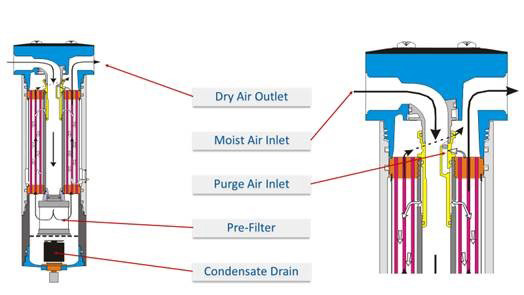
A membrane dryer uses permeable straw-shaped membranes that allow water molecules to pass through them, but not the larger oxygen and nitrogen molecules, which make up 98% of the air in our atmosphere.
Advantages of membrane dryers include:
- Little or no maintenance is required—as they have no moving parts, if they are kept clean of particulate and oil mist, they will last indefinitely.
- No desiccant dust to escape the unit and foul downstream components
Disadvantages of membrane dryers include:
- Oil aerosols can coat the membrane filter element, rendering it useless if adequate pre-filtering is not maintained.
- Some purge air is required.
- The pressure dew point is not as low as can be obtained with a desiccant type dryer.
A desiccant dryer uses an adsorbent material, typically a silica gel, which causes water molecules to adhere or stick to it as the air passes through the desiccant sieve chamber
Advantages of regenerative desiccant type dryers include:
- Very low dew points can be achieved without potential freeze-up.
- Moderate cost of operation for the dew points achieved.
- Heatless type can be designed to operate pneumatically for remote, mobile or hazardous locations.
Disadvantages of regenerative desiccant type dryers include:
- Relatively high initial capital cost
- Periodic replacement of the desiccant bed (typically 3-5 years)
- Oil aerosols can coat the desiccant material, rendering it useless if adequate pre-filtering is not maintained.
- Desiccant dust can sometimes pass out of the chamber used to contain it, potentially causing problems in sensitive downstream components,
- Purge air is required.
